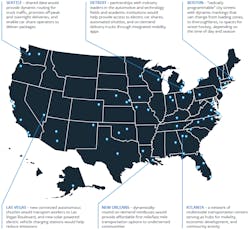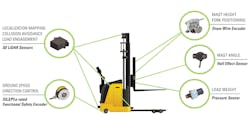Forcing Autonomous Driving to Become a Reality
Smart things are all the rage: Everyone seems to be talking about smart devices, manufacturing, dashboards, cities, and more, with companies pursuing investments and collaborations accordingly. It’s worth asking, however, whether these moves will end up helping individuals and our infrastructure in addition to making companies money.
Many of the other cities plan to continue its Smart plans. For more information about the seven finalist in the Transportaiton.gov challenge, click here. (Credit: Transportation.gov)
Conspiracy or Good Business Strategy?
Fortunately, this so far doesn’t sound like some conspiracy theory to take the public’s money. Just as companies are focused on money, transportation is a large market with a lot of potential for growth with new technologies. According to the Bureau of Transportation Statistics, transportation is the fourth largest expenditure for an American household, accounting for $1.2 trillion in 2016.
The Bureau reports that transportation costs per consumer in 2017 was $15,598, including vehicle purchases, gasoline, other oils, and motor oil. It also states the average income before taxes in 2017 was $73,573. This means, depending on taxes, the average American spends $0.21 to $0.26 per dollar on transportation.
While this is a large market, companies also want to save money. Smart cars are a large part of the move to a smarter infrastructure to reduce congestion. Traffic congestion is costing people 42 hours a year, just sitting wasting gas (double that in Washington D.C.).
Working while commuting might cause motion sickness. However, many ride-share company or autonomous vehicles in general may be the new offices.
Autonomous Driving to Keep the Economy Growing
In August 2015 the Texas A&M Transportation Institute and INRIX (a mobility intelligence company) co-published a report stating that traffic cost Americans $160 billion in 2014, and it is expected to raise to $192 billion in 2020. The cost generally seems to be considered from fuel and delay cost, but didn’t include the negative affects of uncertain or longer delivery times, missed meetings, etc.
Autonomous technology is also considering lower income, or underserved communities that may have to more than double commuting times due to inefficiencies in public transportation. Autonomous driving could bring access to underserved communities. In addition, commuters might not mind a longer commute if they were able to focus on other tasks than driving. Being able to work or play while commuting could alleviate crowded cities. Living farther from cities may not be so bad if the commute was productive.
There are potentially other benefits we haven’t thought of yet. According to RIlind Elezaj, senior link builder at Day Translations, Inc., “This is not the only effect driverless cars will have on our future. Cars and automobiles, in general, are a huge part of our daily lives and society in general. Surprisingly, as humans we are prone to getting angry as soon as we are behind the wheel. So now the questions becomes will driverless cars make us nicer people?”
There is a difference between automated and autonomous. An automated vehicle would stop if it happens across an obstacle, as it adheres to pre-programmed instructions. An autonomous vehicle would adapt and try a different way to reach the final destination (Point B, in this illustration).
The Cost of Traffic
While we could speculate all day, let’s consider where we are currently. According to Transportation.gov, trucks stuck in stop-and-go traffic in metropolitan areas cost shippers an estimated $28 million annually in truck operating costs and wasted fuel, an estimated 30% of traffic in urban areas is caused by cars looking for parking, and outdated traffic signal timing causes more than 10% of all traffic delay on major routes in urban areas.
Autonomous vehicles could greatly reduce issues with parking and signs. To start, “drivers” in an autonomous car would no longer have to contend with getting lost or any need for signage. In addition, connected cars (not even considering the autonomous variety, here) could indicate where a parking spot is available by communicating the distance between the cars around it. It would be possible to see if another vehicle is looking for parking and will get to that spot before you, or if your car is too big for a specific spot. This would mean once your car shows you where a place to park is, it will most likely still be available once you’ve arrived.
However, why park? With autonomous driving, people wouldn’t have to own a car. Carshares could reduce the number of cars needed in a congested area. Autonomous driving might reduce the amount of gas and cars sold every year, but the other benefits and market size is engaging in companies investing to get market shares in this new gold rush. Big business and government representatives understand the importance of population growth, economy, and its connection to transportation.
Autonomous driving is affecting an even larger market if you consider all of the potential applications. Automated guided vehicles are becoming more popular in materials handling applications, where the Industry 4.0 revolution is demonstrating the value of integrated automation.
In December 2015 Transportation.gov launched a Smart City Challenge, asking mid-sized cities across America to develop ideas for an integrated, first-of-its-kind smart transportation system that would use data, applications, and technology to help people and goods move more quickly, cheaply, and efficiently. The Challenge generated an overwhelming response: 78 applicant cities shared the challenges they face and ideas for how to tackle them. Then, seven finalists worked with DOT to further develop their ideas. This wasn’t specifically for autonomous vehicles, but it was in the winning cities’ game plans.
Columbus won the grant and as of the third week of September has self-driving shuttles hitting the streets as part of an initiative announced earlier this year by Smart Columbus and DriveOhio. The project is designed to provide Columbus residents and visitors with education and a first-hand experience with intelligent transportation. The low-speed shuttles will be operated by May Mobility and will begin accepting passengers in December this year.
One of the big reason Columbus won wasn’t because it were going to invest in autonomous driving, but the amount of support they received if they did win. The funding in Columbus now sits at $500 million. How long will it take to go from slow shuttles to make a real change, and how big will outside factors like weather play a role?
Magnetic tape, laser, vision, and natural navigation technologies are the most popularly used in modern AGVs, depending on the specific application.
Current Reality
According to Bloomberg and the Aspen Institute, there are 47 cities currently testing or developing autonomous vehicles. Some have already started rolling out shuttles like the one proposed in Ohio; for example, Paris and Las Vegas. While this might seem like a lot of talk, it is progress. Transportation is a large market and it will not change overnight. However, some underserved areas need help now and are growing impatient.
Unfortunately, autonomous driving has a lot of things to work out and tests to undergo. In several studies the best cities for autonomous driving are in the South. This is for one big reason, weather. Rain, fog, bird poop, snow, and ice are all holding it up.
Could outside factors be too much and end autonomous vehicles? Is autonomous driving this centuries hover car? With so many governments and private companies investing into the technology probably not. Even though some of the cities that are subjected to poor weather are leading the way, it only means once they’ve figure out the worst-case scenario, the other areas will integrate faster and easier.
Perhaps autonomous driving is more like the internet boom around the late ‘90s and early 2000s. It is a high-risk high-reward endeavor, and any company or local government able to manage its way through the autonomous driving maze will win big and set precedent for a paradigm shift for the rest of the world.






